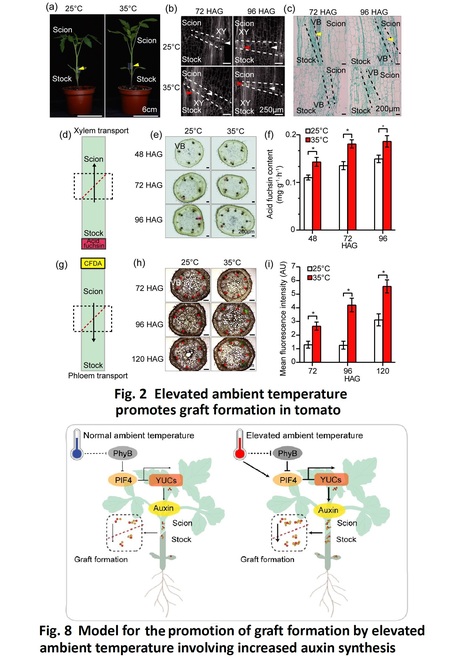Authors: Ai Zhang, Keita Matsuoka, Abdul Kareem, Madalen Robert, Pawel Roszak, Bernhard Blob, Anchal Bisht, Lieven De Veylder, Cătălin Voiniciuc, Masashi Asahina and Charles W. Melnyk.
Current Biology (2022)
Editor's view: Plants require an efficient regeneration system to heal wounds. Zhang et al. identify four DOF transcription factors that are rapidly activated at sites of wounding, graft formation, or tissue cutting. These DOFs are activated by cell-wall damage and auxin to promote tissue regeneration and wound healing.
Highlights: • Four DOF transcription factors are rapidly activated at wounding and grafting sites • Damage to or modifications of the cellulose and pectin matrix activate DOFs • DOFs regulate callus formation, tissue adhesion, and vascular regeneration at wounds • Wound-associated ERF115 and ANAC096 are also activated upon cell-wall damage
Abstract: "Wound healing is a fundamental property of plants and animals that requires recognition of cellular damage to initiate regeneration. In plants, wounding activates a defense response via the production of jasmonic acid and a regeneration response via the hormone auxin and several ethylene response factor (ERF) and NAC domain-containing protein (ANAC) transcription factors. To better understand how plants recognize damage and initiate healing, we searched for factors upregulated during the horticulturally relevant process of plant grafting and found four related DNA binding with one finger (DOF) transcription factors, HIGH CAMBIAL ACTIVITY2 (HCA2), TARGET OF MONOPTEROS6 (TMO6), DOF2.1, and DOF6, whose expression rapidly activated at the Arabidopsis graft junction. Grafting or wounding a quadruple hca2, tmo6, dof2.1, dof6 mutant inhibited vascular and cell-wall-related gene expression. Furthermore, the quadruple dof mutant reduced callus formation, tissue attachment, vascular regeneration, and pectin methylesterification in response to wounding. We also found that activation of DOF gene expression after wounding required auxin, but hormone treatment alone was insufficient for their induction. However, modifying cell walls by enzymatic digestion of cellulose or pectin greatly enhanced TMO6 and HCA2 expression, whereas genetic modifications to the pectin or cellulose matrix using the PECTIN METHYLESTERASE INHIBITOR5 overexpression line or korrigan1 mutant altered TMO6 and HCA2 expression. Changes to the cellulose or pectin matrix were also sufficient to activate the wound-associated ERF115 and ANAC096 transcription factors, suggesting that cell-wall damage represents a common mechanism for wound perception and the promotion of tissue regeneration."
 Your new post is loading...
Your new post is loading...
 Your new post is loading...
Your new post is loading...












